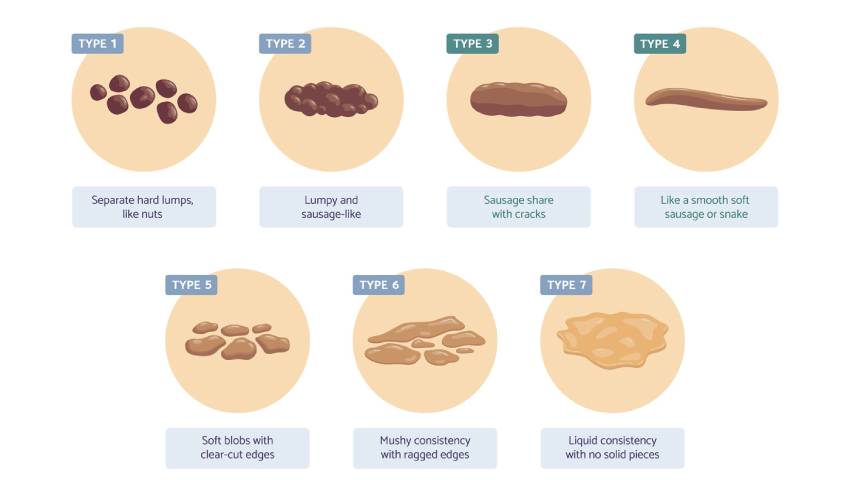
- 03/06/2023
- Kaizen Gastro Care
- 0 Comments
- Proctology
Stool Chart
Maintaining a healthy digestive system is crucial for overall well-being. While many individuals shy away from concerning their bowel movements, paying attention to the quality and consistency of our stool can provide helpful insights into our digestive health. The stool chart, also known as the Bristol Stool Scale, is a visual tool that categorizes different types of stools, helping people and healthcare professionals identify potential digestive problems. In this blog, we will delve into the importance of the stool chart and how it can serve as an informative tool for evaluating digestive health.
What is the Stool Chart?
The stool chart, also known as the Bristol Stool Scale, is a visual classification tool that categorizes different types of stool based on their appearance and consistency. Developed by Dr. Ken Heaton at the University of Bristol, this chart consists of seven different stool types, varying from hard lumps to watery stools. Each type corresponds to a specific state of digestion and can provide helpful information about the health of our gastrointestinal tract.
The Seven Types of Stools:
Let’s explore the seven categories identified on the stool chart:
- Type 1: Separate hard lumps, reaching nuts, are indicative of severe constipation. This type suggests that the stool is paying for an extended period in the colon, resulting in excessive water absorption and hardened stools. Increasing fluid intake and consuming fiber-rich foods can help alleviate this issue.
- Type 2: Lumpy and sausage-shaped – Although slightly better than type 1, this stool is still indicative of constipation. Assuring an adequate intake of water and fiber can help promote regular bowel movements.
- Type 3: Stools in this category appear like sausage but with cracks on the surface. This form represents a healthy stool consistency, suggesting a balanced transit time in the colon.
- Type 4: Described as smooth and snake-like, type 4 stools are considered ideal and indicative of a healthy digestive system. They are easy to pass and suggest a well-functioning gastrointestinal tract.
- Type 5: Soft blobs with clear-cut edges – This type is still within the healthy range but may indicate a slightly accelerated transit time via the colon. It could be a result of raised fiber intake or a temporary change in diet.
- Type 6: Often referred to as mushy stools, this category represents stools with fluffy pieces and ragged edges. Type 6 stools can be a symptom of mild diarrhea, potentially caused by certain foods, medications, or underlying digestive problems.
- Type 7: Watery and entirely liquid – This type represents severe diarrhea and suggests an imbalance in the digestive system. It is essential to stay hydrated and seek medical attention if this persists for a vast period.
The Importance of the Stool Chart:
Monitoring your stool using the Bristol Stool Scale can provide essential knowledge about your digestive health. Here are a few reasons why the stool chart is helpful:
- Detecting Digestive Disorders: By comparing your stool to the chart, you can identify possible digestive diseases such as irritable bowel syndrome (IBS), celiac disease, or Crohn’s disease. Any persistent abnormalities can be discussed with a healthcare professional for further evaluation.
- Tracking Hydration: Stool consistency is closely linked to hydration levels. By observing your stool type regularly, you can measure if you’re sufficiently hydrated or if adjustments need to be made to your fluid intake.
- Assessing Diet and Fiber Intake: The stool chart can provide insights into the significance of your diet and fiber consumption. A consistent Type 4 stool shows a good balance of fiber and hydration, while other types may indicate the need for dietary adjustments.
- Monitoring Overall Health: Changes in stool type or continuous abnormalities can indicate broader health problems beyond digestion, such as malabsorption, inflammation, or infection. Identifying these symptoms early on can help prompt further investigation and treatment.
Factors Affecting Stool Consistency:
Several factors can affect stool consistency, including:
- Diet: Consuming a diet rich in fiber stimulates regular bowel movements and helps sustain healthy stool consistency.
- Hydration: Sufficient water intake is important for maintaining good hydration levels and preventing constipation or overly hard stools.
- Medications: Certain medications, such as antibiotics or those affecting the gastrointestinal tract, can affect stool consistency
- Digestive Diseases: Underlying disorders like irritable bowel syndrome (IBS), Crohn’s disease, or celiac disease can cause variations in stool consistency.
When to Consult a Kaizen Gastro Care?
While occasional variations in stool types are normal, persistent changes or abnormalities should not be ignored. Consult the best gastroenterologist in Pune if you experience:
- Frequent and severe constipation or diarrhea
- Bloody or black stools
- Unexplained weight loss
- Severe abdominal pain or discomfort
- Significant changes in stool habits that persist for more than a few weeks
Conclusion:
Monitoring and understanding your stool using the stool chart can be a helpful tool in evaluating your digestive health. By paying attention to the consistency and appearance of your bowel movements, you can determine potential issues and take proactive steps toward maintaining a healthy digestive system. Maintaining a well-balanced diet, staying hydrated, and promptly addressing any significant changes can help ensure a healthy digestive tract.
Remember, the stool chart is not a diagnostic tool but a helpful guide that can contribute to a better understanding of our body’s overall well-being.
